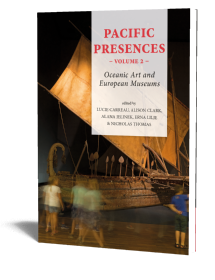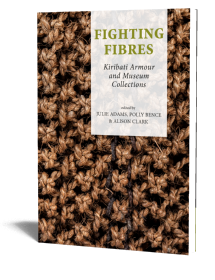Acclimatising to higher ground
The realities of life of a Pacific Atoll People
Keith Dixon | 2021

Acclimatising to higher ground
The realities of life of a Pacific Atoll People
Keith Dixon | 2021
Paperback ISBN: 9789464260298 | Hardback ISBN: 9789464260304 | Imprint: Sidestone Press | Format: 182x257mm | 254 pp. | Language: English | 12 illus. (fc) | Keywords: Nikunau Atoll; I-Nikunau; pathways of history; diaspora; climate change; Kiribati; New Zealand; Great Britain | download cover
Read online 106 times
- Digital & Online access
-
Buy via Sidestone (EU & UK)
-
Buy via our Distributors (WORLD)
For non-EU or UK destinations you can buy our books via our international distributors. Although prices may vary this will ensure speedy delivery and reduction in shipping costs or import tax. But you can also order with us directly via the module above.
UK international distributor
USA international distributor
-
Bookinfo
Paperback ISBN: 9789464260298 | Hardback ISBN: 9789464260304 | Imprint: Sidestone Press | Format: 182x257mm | 254 pp. | Language: English | 12 illus. (fc) | Keywords: Nikunau Atoll; I-Nikunau; pathways of history; diaspora; climate change; Kiribati; New Zealand; Great Britain | download cover
Read online 106 times

We will plant a tree for each order containing a paperback or hardback book via OneTreePlanted.org.
Life for people on atolls is hard, affected by droughts, rough seas and other adverse climatic conditions, and now, rise in sea level threatens their very inhabitance. No wonder kinship is the foundation of atoll societies, traditional and modern! This book presents a multidisciplinary, retrospective analysis of a Pacific Atoll People living in several countries but held together as a diaspora through notions of kinship.
The People have ancestral, cultural, social and continuing residential connections with Nikunau Atoll, at the centre of the Pacific Ocean and once a Cinderella of the British Empire. The analysis explicates their present diasporic circumstances and the pathways through which these arose historically. The intention is to provide a basis for better prospects for succeeding generations from a critical, better-informed standpoint.
The analysis relies on the partisan stance of the author, whose kinship ties with I-Nikunau (= people who identify with Nikunau) are affinal, and his 30-year immersion among the People in question. In addition, a large quantity of literature sources and other secondary data are woven into the analysis, as situations and events are grappled with, articulated, interpreted and written into the book.
The circumstances are analysed under 14 themes, namely, geographical, demographical, economic, environmental, cultural, societal, etc. The analysis should stir the waters of recent research about Nikunau and Kiribati, much of it concerned with environmental changes making uninhabitable Nikunau, Tarawa and other atolls where I-Nikunau reside, and imagining their resettlement on higher ground, for example, New Zealand, where several diasporic communities exist already.
This recent research refers frequently to the social, cultural and economic matters covered in this book, indicating how relevant and important these matters are to the future of I-Nikunau and I-Kiribati. Furthermore, this relevance and importance may apply to the future of other peoples still inhabiting the world’s atolls and facing whatever challenges this future may bring, climate-related and otherwise.
Abstract in Gilbertese
Te Abam’akoro ae Nikunau, e riki inanon ana tai Te Tia Karikib’ai ae Nareau ngke e tabe n anenea kunana ni katabwenaa te Boo ma Te Maaki. Mai ikanne ao a tia ni maeka anti ma aomata ma aomata ake a bungiaki iaona. A m’akuriia abaia b’a ana toronib’ai man inaomata ao ni kukurei. Kaaro ma tiibu a wantongaia ataei karakinan Nikunau, katein Nikunau ao karinean tuan M’aneaban Nikunau. Rikiaia naba kain Nikunau b’a te boborau n taai akekei ni karokoa ngkai. Te nako Tarawa, Nutiran, Buritan ao ai aaba aika raroa nako. Ana kamateb’ai Te -Imatang aei e boboto iaon karakinan te I-Nikunau ma ana kakam’akuri ma ana waaki iaon abana ae Nikunau AO ni boboto riki iaon m’am’a nangaia nakon aaba ake itinanikun Nikunau ike a riki b’a ianena ao tera aroia ni kakam’akuri mani waaki ngkai ai te naan I-Abatera ngaiia.
I INTRODUCTION
1 Research Approach
1.1 Validity of Chosen Themes
1.2 Validity of I-Nikunau as a Study Identity
1.2.1 Utu
1.3 Empirical Materials
1.4 Intent of Applying My Methods
II I-NIKUNAU IN THE PRESENT
2 On Nikunau Atoll
3 On (South) Tarawa
4 Beyond Kiribati
4.1 On Great Britain
4.2 On Te Ika-a-Maui and Te Waipounamu (New Zealand)
III RETROSPECTIVE ANALYSIS OF I-NIKUNAU AND INTERPRETATION OF THEIR CIRCUMSTANCES
5 Geographical Circumstances (te mauri)
5.1 Comings and Goings, and Seeds of Diaspora
5.2 Diaspora taking Roots
5.2.1 Tarawa: Centralisation and Precedence
5.2.2 Consequences for I-Nikunau of Centralisation
5.2.3 Phoenix, Solomon and Line Islands
5.2.4 Metropolitan Countries
6 Demographical Circumstances (te mauri)
6.1 Population of I-Nikunau and of Nikunau
6.2 Settlements on Nikunau
6.3 Settlements in the Diaspora
7 Economic Circumstances (te tabomoa)
7.1 Copra and Money and Non-Traditional Entities on Nikunau
7.2 Dynamics of Economic and Related Developments on and Away from Nikunau
7.2.1 Bartering with Foreign Visitors
7.2.2 Private Trade Stores
7.2.3 Cooperative Trade Stores
7.3 Further Aspects of Economic Change in Kiribati
7.3.1 Tarawa’s Economy
7.3.2 Nikunau’s Economy
7.4 Metropolitan Countries
7.4.1 Backwash and Spread Effects on Tarawa from Metropolitan Countries
8 Environmental Circumstances (te mauri)
8.1 Tarawa’s “Worrisome Trend”
8.2 On Nikunau
8.3 Diasporic Communities on Higher Ground
8.4 Climate Change and Emigration
8.4.1 Immigration Information
9 Biological Circumstances (te mauri)
10 Nutritional and Corporeal Circumstances (te mauri)
10.1 On Nikunau
10.2 Tarawa
10.3 New Zealand
11 Political Circumstances (te raoi)
11.1 Government in Kiribati
11.2 From Mwaneaba District Autonomy on Nikunau to Rule from Tarawa
11.2.1 I-Nikunau governing themselves traditionally on Nikunau
11.2.2 Informal Colonialism on Nikunau
11.2.3 British Colonial Rule
11.2.3.1 Rule De Jure
11.2.3.2 Rule de Facto and de Jure
11.2.4 Rule by I-Kiribati
11.3 I-Nikunau in the Political System
11.4 Quasi-traditional Governance on Nikunau and within Diasporic Communities
12 Spiritual Circumstances (te raoi)
12.1 I-Nikunau’s Traditional Spiritual Beliefs
12.2 Religious “Conversion”
12.2.1 Fundraising
12.3 Consequences of Christianity for I-Nikunau
13 Educational Circumstances (te mauri)
13.1 Outline of Formal Education
13.2 Retrospective Analysis of Education on Nikunau and within Kiribati
13.2.1 Traditional Education
13.2.2 Mission Schools
13.2.3 Primary Schools
13.2.4 Secondary Schools
13.2.5 Tertiary Study
13.3 Esteem and Impact of Non-Traditional Education
13.3.1 Qualifying to Emigrate
13.3.2 Knowledge Varying by Location
13.3.3 Conflicts between Traditional and Formal Education
13.4 Formal Education and its Wider Consequences
14 Social Circumstances (te mauri ao te raoi)
14.1 Mwenga as the Basic Kin Units
14.2 Community Activities and Botaki
14.3 Aba, Lands and People
14.4 Te Katei ni Kiribati and Differentiation
14.5 Unimane, Unaine and other Age and Gender Statuses
14.6 Genealogical Accounts
14.7 Social Categories and Resources of a Colonial and Post-Colonial Nature
15 Organisational Circumstances (te raoi)
15.1 Tradition and Effects of Initial Challenges
15.1.1 The Maritime Trade
15.1.2 Island Administration
15.2 Colonial and Traditional Traits in Present-day Organisations
15.3 Conflicts between the Traditional and Non-traditional
15.4 Diasporic Communities
16 Distributional Circumstances (te tabomoa)
16.1 Distributions among I-Nikunau
16.2 Distributions between I-Nikunau and Others
16.3 Distributions between I-Nikunau Communities
17 Cultural Circumstances (te raoi)
17.1 I-Nikunau Culture
17.2 External Influences on I-Nikunau Culture
18 Societal Circumstances (te mauri ao te raoi)
IV CONCLUSION
References
Dr. Keith Dixon
Keith Dixon’s academic outputs have mainly concerned organisational change, social responsibility, governments, universities, hospitals, mining corporations and accountant education. He has been at his present workplace, the University of Canterbury | Te Whare Wānanga o Waitaha since 2007. Keith’s academic and accounting career has included spells in several locations including the English Midlands, Port Moresby, Tarawa, Buckinghamshire and both main islands of New Zealand. He has worked for organisations as diverse as Wolverhampton, Cannock and Nottinghamshire Councils, the UK Government Department for International Development, the Institute of Public Administration of Papua New Guinea, Kiribati Institute of Technology, Kiribati Centre of the University of the South Pacific, and Massey, Keele and the Open Universities.
Abstract:
Life for people on atolls is hard, affected by droughts, rough seas and other adverse climatic conditions, and now, rise in sea level threatens their very inhabitance. No wonder kinship is the foundation of atoll societies, traditional and modern! This book presents a multidisciplinary, retrospective analysis of a Pacific Atoll People living in several countries but held together as a diaspora through notions of kinship.
The People have ancestral, cultural, social and continuing residential connections with Nikunau Atoll, at the centre of the Pacific Ocean and once a Cinderella of the British Empire. The analysis explicates their present diasporic circumstances and the pathways through which these arose historically. The intention is to provide a basis for better prospects for succeeding generations from a critical, better-informed standpoint.
The analysis relies on the partisan stance of the author, whose kinship ties with I-Nikunau (= people who identify with Nikunau) are affinal, and his 30-year immersion among the People in question. In addition, a large quantity of literature sources and other secondary data are woven into the analysis, as situations and events are grappled with, articulated, interpreted and written into the book.
The circumstances are analysed under 14 themes, namely, geographical, demographical, economic, environmental, cultural, societal, etc. The analysis should stir the waters of recent research about Nikunau and Kiribati, much of it concerned with environmental changes making uninhabitable Nikunau, Tarawa and other atolls where I-Nikunau reside, and imagining their resettlement on higher ground, for example, New Zealand, where several diasporic communities exist already.
This recent research refers frequently to the social, cultural and economic matters covered in this book, indicating how relevant and important these matters are to the future of I-Nikunau and I-Kiribati. Furthermore, this relevance and importance may apply to the future of other peoples still inhabiting the world’s atolls and facing whatever challenges this future may bring, climate-related and otherwise.
Abstract in Gilbertese
Te Abam’akoro ae Nikunau, e riki inanon ana tai Te Tia Karikib’ai ae Nareau ngke e tabe n anenea kunana ni katabwenaa te Boo ma Te Maaki. Mai ikanne ao a tia ni maeka anti ma aomata ma aomata ake a bungiaki iaona. A m’akuriia abaia b’a ana toronib’ai man inaomata ao ni kukurei. Kaaro ma tiibu a wantongaia ataei karakinan Nikunau, katein Nikunau ao karinean tuan M’aneaban Nikunau. Rikiaia naba kain Nikunau b’a te boborau n taai akekei ni karokoa ngkai. Te nako Tarawa, Nutiran, Buritan ao ai aaba aika raroa nako. Ana kamateb’ai Te -Imatang aei e boboto iaon karakinan te I-Nikunau ma ana kakam’akuri ma ana waaki iaon abana ae Nikunau AO ni boboto riki iaon m’am’a nangaia nakon aaba ake itinanikun Nikunau ike a riki b’a ianena ao tera aroia ni kakam’akuri mani waaki ngkai ai te naan I-Abatera ngaiia.
Contents
I INTRODUCTION
1 Research Approach
1.1 Validity of Chosen Themes
1.2 Validity of I-Nikunau as a Study Identity
1.2.1 Utu
1.3 Empirical Materials
1.4 Intent of Applying My Methods
II I-NIKUNAU IN THE PRESENT
2 On Nikunau Atoll
3 On (South) Tarawa
4 Beyond Kiribati
4.1 On Great Britain
4.2 On Te Ika-a-Maui and Te Waipounamu (New Zealand)
III RETROSPECTIVE ANALYSIS OF I-NIKUNAU AND INTERPRETATION OF THEIR CIRCUMSTANCES
5 Geographical Circumstances (te mauri)
5.1 Comings and Goings, and Seeds of Diaspora
5.2 Diaspora taking Roots
5.2.1 Tarawa: Centralisation and Precedence
5.2.2 Consequences for I-Nikunau of Centralisation
5.2.3 Phoenix, Solomon and Line Islands
5.2.4 Metropolitan Countries
6 Demographical Circumstances (te mauri)
6.1 Population of I-Nikunau and of Nikunau
6.2 Settlements on Nikunau
6.3 Settlements in the Diaspora
7 Economic Circumstances (te tabomoa)
7.1 Copra and Money and Non-Traditional Entities on Nikunau
7.2 Dynamics of Economic and Related Developments on and Away from Nikunau
7.2.1 Bartering with Foreign Visitors
7.2.2 Private Trade Stores
7.2.3 Cooperative Trade Stores
7.3 Further Aspects of Economic Change in Kiribati
7.3.1 Tarawa’s Economy
7.3.2 Nikunau’s Economy
7.4 Metropolitan Countries
7.4.1 Backwash and Spread Effects on Tarawa from Metropolitan Countries
8 Environmental Circumstances (te mauri)
8.1 Tarawa’s “Worrisome Trend”
8.2 On Nikunau
8.3 Diasporic Communities on Higher Ground
8.4 Climate Change and Emigration
8.4.1 Immigration Information
9 Biological Circumstances (te mauri)
10 Nutritional and Corporeal Circumstances (te mauri)
10.1 On Nikunau
10.2 Tarawa
10.3 New Zealand
11 Political Circumstances (te raoi)
11.1 Government in Kiribati
11.2 From Mwaneaba District Autonomy on Nikunau to Rule from Tarawa
11.2.1 I-Nikunau governing themselves traditionally on Nikunau
11.2.2 Informal Colonialism on Nikunau
11.2.3 British Colonial Rule
11.2.3.1 Rule De Jure
11.2.3.2 Rule de Facto and de Jure
11.2.4 Rule by I-Kiribati
11.3 I-Nikunau in the Political System
11.4 Quasi-traditional Governance on Nikunau and within Diasporic Communities
12 Spiritual Circumstances (te raoi)
12.1 I-Nikunau’s Traditional Spiritual Beliefs
12.2 Religious “Conversion”
12.2.1 Fundraising
12.3 Consequences of Christianity for I-Nikunau
13 Educational Circumstances (te mauri)
13.1 Outline of Formal Education
13.2 Retrospective Analysis of Education on Nikunau and within Kiribati
13.2.1 Traditional Education
13.2.2 Mission Schools
13.2.3 Primary Schools
13.2.4 Secondary Schools
13.2.5 Tertiary Study
13.3 Esteem and Impact of Non-Traditional Education
13.3.1 Qualifying to Emigrate
13.3.2 Knowledge Varying by Location
13.3.3 Conflicts between Traditional and Formal Education
13.4 Formal Education and its Wider Consequences
14 Social Circumstances (te mauri ao te raoi)
14.1 Mwenga as the Basic Kin Units
14.2 Community Activities and Botaki
14.3 Aba, Lands and People
14.4 Te Katei ni Kiribati and Differentiation
14.5 Unimane, Unaine and other Age and Gender Statuses
14.6 Genealogical Accounts
14.7 Social Categories and Resources of a Colonial and Post-Colonial Nature
15 Organisational Circumstances (te raoi)
15.1 Tradition and Effects of Initial Challenges
15.1.1 The Maritime Trade
15.1.2 Island Administration
15.2 Colonial and Traditional Traits in Present-day Organisations
15.3 Conflicts between the Traditional and Non-traditional
15.4 Diasporic Communities
16 Distributional Circumstances (te tabomoa)
16.1 Distributions among I-Nikunau
16.2 Distributions between I-Nikunau and Others
16.3 Distributions between I-Nikunau Communities
17 Cultural Circumstances (te raoi)
17.1 I-Nikunau Culture
17.2 External Influences on I-Nikunau Culture
18 Societal Circumstances (te mauri ao te raoi)
IV CONCLUSION
References
Dr. Keith Dixon
Keith Dixon’s academic outputs have mainly concerned organisational change, social responsibility, governments, universities, hospitals, mining corporations and accountant education. He has been at his present workplace, the University of Canterbury | Te Whare Wānanga o Waitaha since 2007. Keith’s academic and accounting career has included spells in several locations including the English Midlands, Port Moresby, Tarawa, Buckinghamshire and both main islands of New Zealand. He has worked for organisations as diverse as Wolverhampton, Cannock and Nottinghamshire Councils, the UK Government Department for International Development, the Institute of Public Administration of Papua New Guinea, Kiribati Institute of Technology, Kiribati Centre of the University of the South Pacific, and Massey, Keele and the Open Universities.
- Digital & Online access
-
Buy via Sidestone (EU & UK)
-
Buy via our Distributors (WORLD)
For non-EU or UK destinations you can buy our books via our international distributors. Although prices may vary this will ensure speedy delivery and reduction in shipping costs or import tax. But you can also order with us directly via the module above.
UK international distributor
USA international distributor
- Browse all books by subject
-
Search all books

We will plant a tree for each order containing a paperback or hardback book via OneTreePlanted.org.
You might also like:
© 2025 Sidestone Press KvK nr. 28114891 Privacy policy Sidestone Newsletter Terms and Conditions (Dutch)








